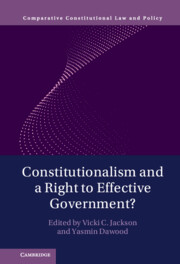Book contents
- Constitutionalism and a Right to Effective Government?
- Comparative Constitutional Law and Policy
- Constitutionalism and a Right to Effective Government?
- Copyright page
- Dedication
- Contents
- Tables
- Contributors
- Acknowledgments
- Part I Introduction
- Part II What Are Constitutions For?
- 2 Resolution and Accommodation in the Good Constitution
- 3 Effective Governance and the Social Dimension of the Rule of Law
- 4 Effective Government and the Two Faces of Constitutionalism
- 5 The Right to Effective Self-Government
- Part III Positive Rights and Rights to Effective Self-Government
- Part IV The Role of Courts in Building State Capacity and Promoting Effective Self-Government While Protecting Rights
- Part V Executive and Administrative Constitutionalism in Effective Democratic Government
- Part VI Legislatures, Representation, and Duties of Effective Self-Government
- Part VII Politics, Sociology, Media, and Corruption as Contexts for Constitutionalism and Governance
- Index
2 - Resolution and Accommodation in the Good Constitution
from Part II - What Are Constitutions For?
Published online by Cambridge University Press: 20 October 2022
- Constitutionalism and a Right to Effective Government?
- Comparative Constitutional Law and Policy
- Constitutionalism and a Right to Effective Government?
- Copyright page
- Dedication
- Contents
- Tables
- Contributors
- Acknowledgments
- Part I Introduction
- Part II What Are Constitutions For?
- 2 Resolution and Accommodation in the Good Constitution
- 3 Effective Governance and the Social Dimension of the Rule of Law
- 4 Effective Government and the Two Faces of Constitutionalism
- 5 The Right to Effective Self-Government
- Part III Positive Rights and Rights to Effective Self-Government
- Part IV The Role of Courts in Building State Capacity and Promoting Effective Self-Government While Protecting Rights
- Part V Executive and Administrative Constitutionalism in Effective Democratic Government
- Part VI Legislatures, Representation, and Duties of Effective Self-Government
- Part VII Politics, Sociology, Media, and Corruption as Contexts for Constitutionalism and Governance
- Index
Summary
Those who ask what counts as a good constitution normally mean to ask a different question; that is, they mean to ask what counts as a good state. Most people do not care whether the wording of the constitution is elegant or crude, whether its structure is clear or complex, or whether it was produced by an elected convention or is an accident of history, and, generally, they are right not to care: what matters is the state that the constitution has produced. When the state is succeeding in its primary task of advancing its people’s well-being, the constitution is, by derivation, successful too.1 But whilst the constitution is defined by its relationship to the state – the assemblage of rules which creates that institution – it remains an instrument in its own right, distinct from the state which it creates. This chapter asks whether there are features of the constitution that can render it, in itself, good, separately from the state it constitutes. An answer to this question would need to show that the constitution, as a bare set of rules, can play a part in helping the state achieve its primary task, distinct from the construction and operation of the constitutional institutions it instantiates. Though a range of answers to this question could be given, this chapter will examine two contenders. Each of these provides ways in which the constitution might, in itself, serve to moderate disagreement within the community and help unite people behind the state.
Keywords
- Type
- Chapter
- Information
- Constitutionalism and a Right to Effective Government? , pp. 23 - 33Publisher: Cambridge University PressPrint publication year: 2022



